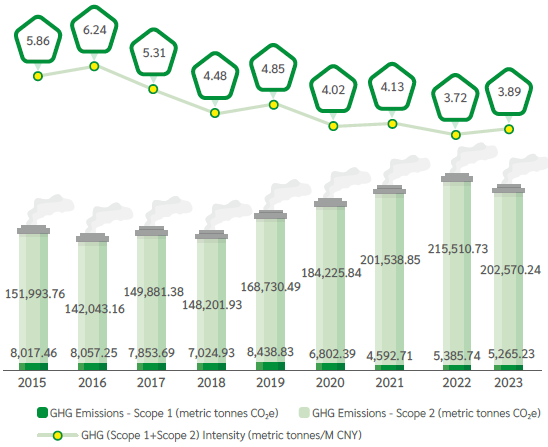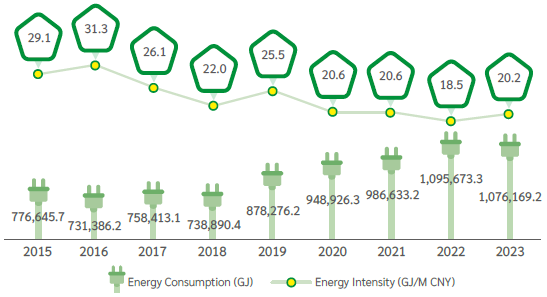
Environmental Protection and Occupational Safety
Nature, Climate Change and Carbon Management
USI integrates the environment sustainable development principle with business decisionmaking and operation management, and the Board of Directors and senior officers take up the management responsibility and consider the recommendations and expectations of all stakeholders to establish corresponding management policies. In accordance with relevant management systems of ISO 14001, ISO 50001, and ISO 14064-1, the Company's internal management procedures are established. Internal employees' awareness of environmental protection are trained, and material environmental consideration items are identified continuously, such as air pollution, water pollution, wastes, toxic chemicals, noise pollution, soil pollution and energy resources are improved. We are committed to improving and reducing the negative impact of business operations on the environment. Furthermore, we also publicly disclose the Company's environmental information and fulfill corporate environmental responsibilities.
The global warming caused by GHG emissions over the years has exposed the world economy to significant risks and has threatened many businesses around the world. Accordingly, stakeholders have started to pay attention to climate-related risks and opportunities. The Company also supports and responds to the goal of the Paris Agreement and has explicitly disclosed the risks and opportunities faced by the Company due to climate change and related to the nature according to the TCFD and TNFD frameworks, thereby proposing corresponding strategies and measures. Please refer to the 2023 Climate and Nature Risk Management Report for further information in detail. The USI Sustainability Committee is the dedicated unit for climate change related management to understand and analyze sustainable development topics related to the Company according to various domestic and foreign sustainable development and climate change related international initiative activities.

USI attaches great importance to the supply, regulation, support and cultural services provided by the ecosystem for company operations, and is committed to reducing the impact on the ecosystem. Currently, the Mainland China, Nantou, Mexico and Vietnam facilities are all located in high-tech parks and industrial parks. None of the parks are located in biodiversity-sensitive areas.
Biodiversity Commitment
To achieve a balanced coexistence and maintain the integrity of natural ecosystems and forest conservation, USI established our Biodiversity and No Deforestation Commitment and publicly disclosed our biodiversity targets:
- Target Objective: to work towards No Net Loss (NNL) and No Gross Deforestation across our operations and value chain, we establish a global monitoring system to track biodiversity loss and comply with statutory biodiversity and forest conservation regulations, reducing environmental impacts and dependencies in the best practicable way.
- Risk Assessment: USI engages with internal and external stakeholders to assess potential biodiversity and deforestation risks following international guidelines. We analyze dependencies and impacts, consider local operational and ecological characteristics, identify priority areas to work on, and manage material risks by developing action plans with clear and measurable metrics.
- Mitigating Impact: to balance our impact on the ecosystem, USI adopts a nature-based mitigation hierarchy approach of prevention, mitigation, restoration, and offsetting throughout the operation life cycle to investigate and monitor material risks, protect biodiversity and ecosystem services, and prevent deforestation or invasive species.
- Scope of Coverage: all operations, suppliers, and partners are subject to the Commitment. New Facilities and value chain operational activities are prohibited, where avoidable, to be located near sites containing globally or nationally important biodiversity, environmentally-sensitive hotspots, ecological corridors, in areas contiguous with hydrological and vegetation conditions, or the vicinity of the sites mentioned above.
With the Board of Directors’ endorsement and approval, this Commitment is implemented across all operating sites, subsidiaries, suppliers, and business partners inside and outside the value chain worldwide to achieve the long-term goal of 2050 Net Positive Impact (NPI).
As part of our restoration efforts, USI began afforestation in partnership with an organization in 2013 to increase biodiversity and soil and water conservation. In addition, to reduce the Potentially Disappeared Fraction of species and achieve No Gross Deforestation by 2050, USI continues the hierarchical mitigation approach of prevention, mitigation, restoration, and offsetting in our facilities and carry out measures such as energy saving, carbon reduction, and resource recovery to ameliorate our impact.
Biodiversity Dependence and Impact Analysis
We use the LEAP (Locate, Evaluate, Assess, Prepare) process recommended by the TNFD framework to conduct biodiversity dependence and impact assessments on USI's existing own sites and supplier sites.
Biodiversity Risk Assessment Process

A questionnaire survey was conducted at each facility site of the company, and the identification results of natural dependence categories in each facility area showed that the issue that affects the most facility areas is high temperature, followed by extreme rainfall and stronger wind disasters. The two disasters of "uneven rainfall" and "drought occurrence" have a high impact before adjustment. All disaster risks have a downward trend after the implementation of adaptation actions in each factory area. The identification results of the natural impact categories of each factory area show that the highest impact (pollution) issues caused by the factory area on nature include waste, greenhouse gas emissions, and air pollution emissions, followed by indirect energy use, direct use of fossil fuels, and use of fresh water resources.
For analysis of the financial impact of climate change risks and opportunities, refer to the International Energy Agency (IEA), the International Renewable Energy Agency (IRENA), the Intergovernmental Panel on Climate Change Sixth Assessment Reports (IPCC AR6), and the Nationally Determined Contribution (NDC) situational parameters set for each manufacturing location. The risks and opportunities of the company's entities and transformation are analyzed with relevant units within the organization.
Based on the risk and opportunity matrix identification results, climate risk projects of high concern are managed from two aspects: "Mitigation and Adaptation". In terms of mitigation, we actively promote sustainable manufacturing, use of renewable energy and improve energy resource efficiency; in terms of adaptation, we strengthen The company's climate resilience and search for alternative energy sources analyze the risks of climate change and propose research and development strategies, provide customers with integrated solutions, and help customers adapt to climate change.
USI expects to gradually plan to obtain high-quality carbon rights in 2037 to offset the remaining carbon emissions, and announces the goal of achieving net-zero carbon emissions in 2040. It will continue to mitigate and adapt to climate change and implement energy management, water resources management, and waste management. management and air pollution prevention, and assist customers in producing energy-saving and carbon-reducing products. At the same time, a systematic disclosure structure will be used to demonstrate the efforts and results in response to climate change, further enhance awareness of the climate crisis, formulate relevant mitigation plans and measures, accelerate the implementation of risk control and climate change mitigation actions, and strengthen ongoing management of operations. capabilities and move towards sustainable development of the enterprise.
Net Zero Carbon Emissions Roadmap

USI continues to promote greenhouse gas reduction policies and conducts internal greenhouse gas inventory in accordance with the ISO 14064-1 standard. It is verified through a third-party verification agency that the total greenhouse gas emissions in 2023 will be 207,835.48 metric tons CO2e(Scope 1 & 2),with 13,061 metric tonnes of CO2e reduction from 2022, and the GHG emissions intensity was 3.89 metric tonnes of CO2e, an increase of 0.17 metric tonnes from 2022.

We conduct 15 categories of significant identification and inventory of upstream and downstream activities in Scope 3, the results of which were verified by a third-party verification unit as follows:
| Category(1) | Description | Greenhouse Gas Emissions |
| 1 | Purchased goods and services | 6,838,088.66 |
| 2 | Capital goods | 41,538.36 |
| 3 | Fuel and energy related activities | 16,149.55 |
| 4 | Upstream transportation and distribution | 88,896.98 |
| 5 | Waste generated in operations | 820.60 |
| 6 | Business travel | 621.27 |
| 7 | Employee commuting | 10,128.89 |
| 8 | Upstream leased assets | 2,465.08 |
| 9 | Downstream transportation and distribution | 32,826.53 |
| 10 | Processing of sold products | N/A(2) |
| 11 | Use of sold products | N/A |
| 12 | End-of-life treatment of sold products | N/A |
| 13 | Downstream leased assets | N/A |
| 14 | Franchises | N/A |
| 15 | Investments | 844,182.71 |
| Total | 7,875,718.63 | |
Note:
1. The data presented came from the ISO 14064-1:2018 inventory results, rounded to the 2nd decimal place, converted to the GHG Protocol for disclosure
2. N/A: Non-significant after assessment of the indirect emissions materiality criteria in accordance with ISO 14064-1:2018
In the green-house gas emissions, power loss shares about 96.9% in USI. The key to reducing carbon emission is to save power, making maximum efforts for electricity efficiency. The total energy consumption in 2023 will be 1,076,169.2 gigajoules, a decrease of 19,504.1 gigajoules compared with 2022. Based on the turnover analysis, the energy consumption per million yuan of turnover in 2023 will increase by 1.7 gigajoules compared with 2022. The electricity consumption intensity in 2015 was 29.1 (gigajoules/million yuan), and the electricity consumption intensity in 2023 will be 20.2 (gigajoules/million yuan), a decrease of 30.8% from 2015.

| Category | Direct Energy Consumption | Indirect Energy Consumption | Total Energy Consumption | ||
| Diesel | Gasoline | Natural Gas/Liquid Petrol Gas | Electricity | ||
| 2023 | 1,225.2 | 2,277.3 | 30,110.9 | 1,042,555.7 | 1,076,169.2 |
| 2022 | 1,266.0 | 2,215.4 | 28,307.9 | 1,063,884.0 | 1,095,673.3 |
| 2021 | 1,335.8 | 2,575.2 | 34,239.0 | 948,483.2 | 986,633.2 |
| 2020 | 1,393.6 | 2,523.9 | 74,103.6 | 870,905.2 | 948,926.3 |
USI actively responds to the call for renewable energy use. We purchased 236,432 MWh International REC (I-REC, the registration authority is I-REC Registry and GEC, Green Electricity Certificate) in 2024 to offset CO2e emitted by traditional power in 2023 (the annual electricity use for Zhangjiang, Jinqiao, Huizhou, Kunshan, Mexico and Vietnam Facilities were all offset). Low-carbon products produced in facilities using renewable energy accounts for 60.5% of USI's annual revenue. According to GHG Protocol Scope 2 Guidance, the statements are used to neutralize Scope 2 Market-based emissions.
| Category | Item | Scope 1 | Scope 2 | Total |
|---|---|---|---|---|
| Location based | GHG Emissions (Metric tonnes CO2e) | 5,265.23 | 202,570.24 | 207,835.48 |
| Percentage(%) | 3 | 97 | 100 | |
| Market based | GHG Emissions (Metric tonnes CO2e) | 5,265.23 | 26,286.99 | 31,552.22 |
| Percentage(%) | 17 | 83 | 100 |


